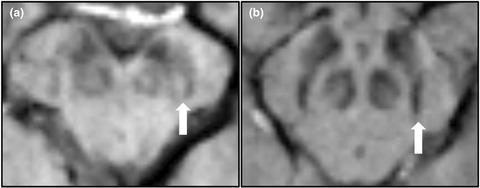当前位置:
X-MOL 学术
›
Brain Behav.
›
论文详情
Our official English website, www.x-mol.net, welcomes your
feedback! (Note: you will need to create a separate account there.)
Clinical MR imaging in Parkinson’s disease: How useful is the swallow tail sign?
Brain and Behavior ( IF 2.6 ) Pub Date : 2021-05-24 , DOI: 10.1002/brb3.2202 Jannik Prasuhn 1, 2, 3 , Alexander Neumann 4 , Robert Strautz 1, 2, 5 , Shalida Dreischmeier 1, 2 , Felicitas Lemmer 1, 2 , Henrike Hanssen 1, 2, 3 , Marcus Heldmann 2, 3, 6 , Peter Schramm 4 , Norbert Brüggemann 1, 2, 3
Brain and Behavior ( IF 2.6 ) Pub Date : 2021-05-24 , DOI: 10.1002/brb3.2202 Jannik Prasuhn 1, 2, 3 , Alexander Neumann 4 , Robert Strautz 1, 2, 5 , Shalida Dreischmeier 1, 2 , Felicitas Lemmer 1, 2 , Henrike Hanssen 1, 2, 3 , Marcus Heldmann 2, 3, 6 , Peter Schramm 4 , Norbert Brüggemann 1, 2, 3
Affiliation

|
With conventional MRI, no Parkinson's disease (PD)-specific abnormalities can be detected. However, there is a critical need for accompanying neuroimaging markers to guide the diagnosis. With high-resolution susceptibility-weighted MRI (SWI) sequences, the imaging of nigrosome-1 (N1) is possible. The so-called swallow tail sign (STS) has been proposed as a suitable neuroimaging marker for the diagnosis of PD.
中文翻译:

帕金森病的临床磁共振成像:燕尾征有多大用处?
使用常规 MRI,无法检测到帕金森病 (PD) 特异性异常。然而,迫切需要伴随神经影像学标志物来指导诊断。使用高分辨率磁敏感加权 MRI (SWI) 序列,可以对 nigrosome-1 (N1) 进行成像。所谓的燕尾征 (STS) 已被提议作为诊断 PD 的合适神经影像学标志物。
更新日期:2021-07-30
中文翻译:

帕金森病的临床磁共振成像:燕尾征有多大用处?
使用常规 MRI,无法检测到帕金森病 (PD) 特异性异常。然而,迫切需要伴随神经影像学标志物来指导诊断。使用高分辨率磁敏感加权 MRI (SWI) 序列,可以对 nigrosome-1 (N1) 进行成像。所谓的燕尾征 (STS) 已被提议作为诊断 PD 的合适神经影像学标志物。











































 京公网安备 11010802027423号
京公网安备 11010802027423号